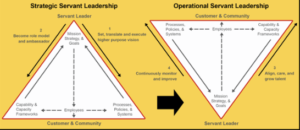Red e App recently published a whitepaper entitled “Strange Bedfellows: The Convergence of Innovation and Compliance in Long Term Care” – focused on the future of the long term healthcare workforce, the role technology will play, and why compliance and innovation must coexist. This post is an excerpt from the full document, focusing on Work Trust, and is part of a series of blogs that will be released discussing various topics from the whitepaper.
Work trust is a behavioral outcome that results from an organization’s quantitative and qualitative investment in creating a culture of care that enables strong operational leadership and empowers the workforce.
Work trust most often exhibits itself in the form of a feeling of being supported, empowered, and part of a collective for the betterment of both the individual and the whole. Work trust is central to a healthy ecosystem whereby individuals, and by association, a company, can thrive. It’s also a critical driver for employee engagement. Qualitatively, the behaviors exhibited by leadership have a marked impact on work trust, which in turn can be measured by levels of employee engagement, performance, and retention.
On one end of the spectrum, you have a style of leadership that can be characterized as parent and child. Leaders see themselves as providers, driving performance through control and measuring success in terms of outputs. In exchange for jobs and compensation, they expect loyalty from their employees and seek to reinforce behaviors that lead to desired outcomes that benefit the company, if not the employee.
On the other end of the spectrum is a style of leadership that is characterized by the principles of servant leadership, whereby control is shared and success is measured through the growth and development of the workforce.
Employees can add value, they see the potential for development, and there is a shared sense of purpose. As individuals move further along the spectrum toward servant leadership, work trust replaces one-sided expectations of loyalty, and there is an increase in the likelihood of improved employee engagement, performance, and retention.
The principles of servant leadership map well to long-term care, as well as in other healthcare organizations, where the non-desk workforce operates through collaboration and with a great deal of autonomy.
According to Coetzer, Bussin, and Geldenhuys at the University of Johannesburg, over time, servant leadership can transition from strategic to operational. In operational leadership, the hierarchy is flipped upside-down, and the servant leader serves and empowers employees to achieve the higher purpose vision (as originally established in strategic servant leadership).
In this way, employees do not serve the leader at the expense of the customer, but employees are served and empowered by the leader to render exceptional customer service in line with the set vision and to help followers become servant leaders themselves.
Figure 5: Servant Leadership – flipping the hierarchy
Intent and behavioral modification on their own is not enough, however. Companies who commit to the creation of work trust also need to set aside a budget to invest in an operational infrastructure that enables real and effective connection. Within the ecosystem of an organization, the operational infrastructure is made up of people, business processes, and supporting technology. Processes and technology should be structured to complement an existing hierarchy, accounting for formal as well as informal elements.
Additionally, it should be built to empower leaders and deliver desired outcomes through the support of its intended audience. Your communication tools must enable strong communication to and through your managers at every level.
In our next post, we will discuss the importance of budgeting to build work trust. Click the link to read the entirety of “Strange Bedfellows: The Convergence of Innovation and Compliance in Long Term Care“.
